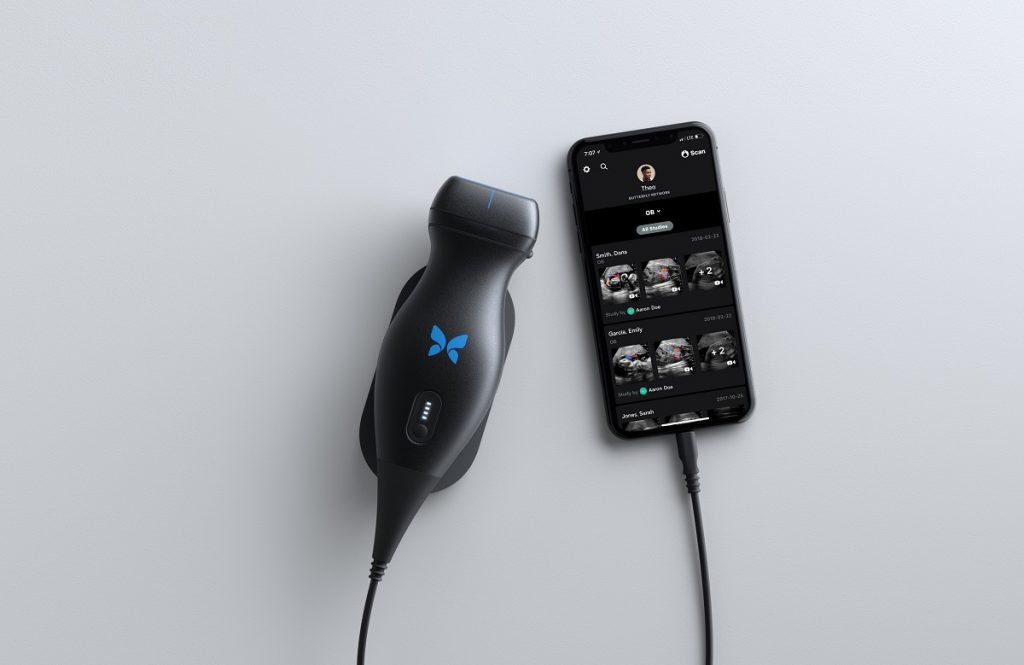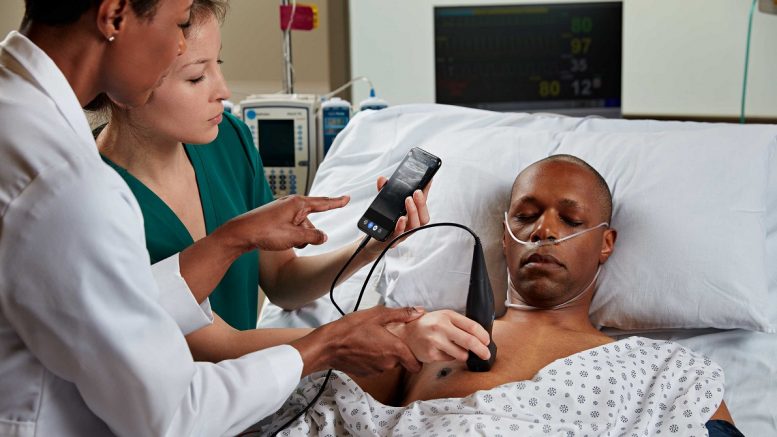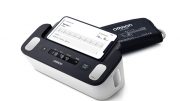Dr. John Martin, Chief Medical Officer at Butterfly Network, talks to The Journal of mHealth about the potential impact of its Butterfly iQ device, which enables low-cost, portable, whole body ultrasound at the point-of-care.
Where do you see the initial opportunities for Butterfly iQ and Point-of-Care Ultrasound (POCUS)?
Peer reviewed Medical journals have published extensively on the benefits of bedside ultrasound. A recent publication in JAMA, by a renowned Cardiologist, goes so far as to suggest it should be included as a routine part of the physical exam. While the movement toward this objective is well underway in many specialties, adoption has been limited by two problems: cost and ease of use. With the introduction of Butterfly iQ, ultrasound technology has been reinvented from the ground up, making medical imaging both affordable and versatile, fueling a movement by all specialties to include bedside ultrasound in care delivery models.
What are some of the main features of the Butterfly iQ device that benefit clinicians?
In short, Butterfly iQ is the first handheld whole-body ultrasound system. Powered by a single silicon chip on a portable, smartphone-connected device, Butterfly makes point of care ultrasound (POCUS) as accessible as a stethoscope. In addition to ease of use, the device is much more affordable than traditional systems, which can cost upwards of £40,000, whereas Butterfly iQ starts at £1699.
Butterfly iQ’s ultrasound-on-chip technology allows a single probe to have linear, phased and curved array configurations across the broad spectrum of frequencies needed to scan different parts of the entire body. The result is a whole-body ultrasound system that is unlike any device on the market. Butterfly iQ was cleared by the FDA and CE Mark for 13 indications, making it the broadest clearance ever for a single ultrasound transducer. For clinicians, this means that they can scan the entire body using one probe, meaning they can diagnose a vast array of conditions faster, and with more ease.
Versatility is so important – many hospital procedures are typically done bedside with a traditional ultrasound system being rolled around from patient to patient. With the limited number of technicians and ultrasound devices available, patients often experience extended hospital stay to complete ordered studies, but with a Butterfly iQ in their pocket, Doctors can perform scans quickly, at the bedside, without having to wait for a large device to be free.
How is the solution changing point-of-care workflows and processes for healthcare providers?
Butterfly iQ’s handheld system makes ultrasound as accessible as a stethoscope. With point of care ultrasound, providers can save time in diagnosing patients and begin treatment sooner. Saving time from presentation to treatment improves outcomes, lowers costs and improves physician and patient satisfaction. From before we are born to the later stages of life, for almost every condition, ultrasound can play a vital role. Now it is possible with an affordable, versatile and intuitive device.
The second largest group of physicians purchasing this device in the United States are people in primary care or GPs because they see the value. They don’t want to send their patients off for tests and wait for the results, they’d like to get the answers to simple questions in their office right away. That’s the most efficient way to deliver care and it’s the most cost-effective way.
The technology obviously has the potential to significantly change point-of-care imaging and subsequent treatment pathways – but what are some of the challenges you are facing when it comes to encouraging adoption?
The important thing to be clear on when talking about POCUS and the role of Butterfly iQ is that it is different from comprehensive diagnostic sonography such as radiology ultrasound and echocardiography, and is not trying to replace these in-depth diagnostics scans. The value of the Butterfly iQ is in its accessibility and versatility for routine use of ultrasound at the bedside, the role of which is to ask a binary question, and generate a focused answer, expediting care and diagnosis, as well as improving patient safety.
High end ultrasound systems which have advanced features can provide a different level of imaging are not replaced by handheld systems. Those specialized machines still have an important role to play in healthcare. For Butterfly, the focus at the moment is to greatly expand access to ultrasound, democratizing healthcare and impacting as many lives as possible.
By reducing the cost, and access to POCUS, you are democratizing image-based healthcare, how do you intend to further support this with access to training and image analysis/interpretation?
Any qualified healthcare provider (i.e. physician, paramedic, RN) can be trained to use Butterfly iQ. For support, we have a dedicated team that customers connect with over phone or email. Additionally, Butterfly has an education platform: The Butterfly Education Platform is a diverse video library of ultrasound education taught by experts on how to acquire images and how to interpret them (https://cloud.butterflynetwork.com/-/edu)
With an integrated software platform, Butterfly also provides a seamless connection for professionals to collaborate across the hospital or around the world. According to the World Health Organization, ultrasound is one of two essential medical imaging modalities. However, even in the developed world, price and lack of expertise are barriers that prevent access to ultrasound. By putting ultrasound on a chip and creating an integrated software platform that allows for intuitive collaboration between healthcare professionals – including those in the most remote areas of the world – Butterfly iQ is paving the way for early detection and remote diagnosis of health issues around the world.
Are you seeing an appetite from healthcare organizations to increase training and increase the application of POCUS?
Absolutely. There are a number of doctors across the UK that are working hard to introduce POCUS training. At Dublin’s Mater Misericordiae University Hospital, consultant in Emergency Medicine and co-director of Emergency Ultrasound Education, Dr Mcdermott, is using Butterfly iQ to run POCUS training days – attendees have included GPs, physios and emergency physicians, all looking to empower themselves to make rapid, accurate diagnosis of their patients.
Over in Africa, we are working with health charity Bridge to Health, who are using Butterfly iQ to train clinicians to scan for pneumonia, and obstetric complications.

To what extent can software enhancements like machine learning and AI-enabled image interpretation help make POCUS more mainstream?
One of the biggest challenges with using ultrasound is the complexity and skill required to capture an image that is diagnostically relevant. We address this using novel artificial intelligence tools in Butterfly iQ that shows a scale to help signal when the user has captured a “good” image. Hundreds of thousands of images will have been annotated as “good” or “bad” to help train the complex deep learning algorithms. In addition, we are developing tools to assist in interpretations. An example is bedside cardiac imaging. Once a “good” image is captured, the AI technology will then perform an automated interpretation to compute the ejection fraction. There will then be an opportunity for the user to adjust the automated interpretation and recalculate the ejection fraction.
Butterfly’s AI technology has created a drastically simpler system for clinicians to utilize ultrasound in their daily practice, assisting them in finding appropriate views and performing automated assessments. This technology is paired with an integrated software platform that provides a connection for professionals to collaborate across the hospital or around the world. With this, healthcare professionals – including those in the most remote areas of the globe – have access to an imaging device that allows for remote capture, commentating and assessment.
What does the future look like for Butterfly iQ?
The technological combination of hardware, cloud and AI will allow data to be continuously fed to our intelligence ecosystem, improving our AI technology rapidly, as more users scan with Butterfly iQ. Every user in the Butterfly community will improve our technology, making our solutions more intuitive and accurate.
Butterfly is a mission-driven company whose core goal is to democratize healthcare by making medical imaging accessible and affordable to everyone. We have just introduced 10 new compatible Android devices, further democratizing and increasing access to medical imaging.
Approximately 4.7 billion people are unable to obtain medical imaging in the world. By putting ultrasound on a chip and creating an integrated software platform that allows for intuitive collaboration between healthcare professionals – including those in the most remote areas of the world – Butterfly iQ is paving the way for early detection and remote diagnosis of health issues around the world.
Ultimately, our system will empower patients to scan themselves, treating their conditions much earlier, or even preventing certain conditions from developing to save the lives of those we love.





